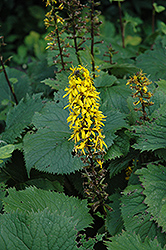Fri & Sat 8am - 8pm
Sun 8am - 7pm
Anytown, USA 12345
fax: 261.787.0463
e-mail: info@successgc.com


Plant Finder

Plant Height: 3 feet
Flower Height: 6 feet
Spread: 3 feet
Sunlight:
![]()
![]()
Hardiness Zone: 2b
Other Names: Rayflower
Ornamental Features
Giant Groundsel features bold spikes of yellow flowers rising above the foliage from early to mid summer. Its large serrated round leaves remain forest green in color throughout the season.
Landscape Attributes
Giant Groundsel is an herbaceous perennial with a rigidly upright and towering form. Its wonderfully bold, coarse texture can be very effective in a balanced garden composition.
This is a relatively low maintenance plant, and is best cleaned up in early spring before it resumes active growth for the season. Deer don't particularly care for this plant and will usually leave it alone in favor of tastier treats. It has no significant negative characteristics.
Giant Groundsel is recommended for the following landscape applications;
- Vertical Accent
- Mass Planting
- General Garden Use
- Bog Gardens
Planting & Growing
Giant Groundsel will grow to be about 3 feet tall at maturity extending to 6 feet tall with the flowers, with a spread of 3 feet. It grows at a medium rate, and under ideal conditions can be expected to live for approximately 20 years. As an herbaceous perennial, this plant will usually die back to the crown each winter, and will regrow from the base each spring. Be careful not to disturb the crown in late winter when it may not be readily seen!
This plant does best in partial shade to shade. It prefers to grow in moist to wet soil, and will even tolerate some standing water. It is not particular as to soil pH, but grows best in rich soils. It is somewhat tolerant of urban pollution. This species is not originally from North America. It can be propagated by division.
